NOTE: This timeline has been replaced by Third Indiction. While Battle of Manzikert will still receive occasional updates, it will be superseded by the former. Kaiser1918oftheGloriousGermanReich (talk) 23:24, 29 September 2023 (UTC)
In our timeline, the Battle of Manzikert was a pivotal battle in 1071 between the Eastern Roman Empire and the Seljuk Turkish Empire. Due to part of the Byzantine force backstabbing the rest of the army due to convoluted political differences and the overconfidence of the Byzantine Emperor Romanos IV, the Turks, despite the fact that the Byzantines were initially winning, won the battle. The Byzantine Emperor was captured by the ingenious Turkish leader, Alps Arslan. Though he ultimately made peace with the Byzantines, following rulers and conflicts would result in the Byzantine loss of all of Anatolia in the span of a few years. The Crusades began due to this, which ultimately failed and sealed the chances for Byzantine survival.
This battle was one of the most decisive battles in history in terms of political and cultural ramifications. It begs the question: What if Byzantium had been triumphant in the battle?
Point of Divergence[]
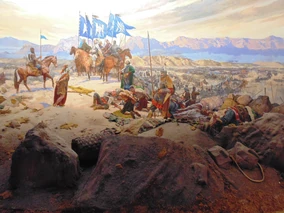
The Roman Victory at Manzikert by John Alexios. Painted in 1899.
1071: The Byzantines win the Battle of Manzikert, and Anatolia remains in Byzantine hands. The Turkish defeat sparks a series of humiliating defeats that lead the Turks to sue for peace, ceding Transcaucasia. The Turks occasionally for the next century to start insurgencies to disrupt the region. The Crusades (as we know them at last) never occur, being delayed and occurring largely in Europe as an extension of the Reconquista and Baltic Crusades.
1071-1200[]
1071-1100: Collapse of the Seljuk Turks[]
With the humiliation inflicted upon the Seljuks during the war, the Seljuks faced a tumultuous age of instability and turmoil after the abdication and death of Alp Arslan. Malik-Shah, a great gatherer of Seljuk lands in OTL, was a politically insignificant monarch in TTL. His death in 1092 led to the collapse of the empire into numerous rump states. The Crusades also never happen without the power vacuum that followed the Byzantine loss at Manzikert that led to Alexios I Kommenos requesting aid from the west to reintegrate the Anatolian territories
Speaking of Alexios I, his dynasty would never be established for an extended period of time. Instead, with the Doukas Family being defeated, the Diogenes (Diogenid, or alternatively, the Cappadocian Dynasty) reign until the dawn of the 13th century. Romanos IV dies in 1091 due to pneumonia, and his son and Junior Emperor, Nikephoros III, succeeds to the Byzantine throne. His reign marked the consolidation of Byzantine acquisitions in the east. He married a young widow prior to these events named Anthusa Ptochoprodroma, a noblewoman from the city of Sinope. They had six sons and one daughter. Out of the seven children, only three of them were legitimate, Thomas, Alexios, and Anthemia (the daughter). Alexios was delegitimized in 1100 under pressure from the staunchly anti-Catholic Clergy after he married the daughter of a Norman noble the year prior.
12th Century[]
Nikephoros died while crushing Armenian zealots in 1102. Thomas, I was crowned emperor and after squashing the Armenian rebellion he pursued the Hungarians after the former Byzantine vassal state of Croatia entered a personal union with Hungary in 1102. He was somewhat successful, however, this sudden incursion started nearly a thousand years of animosity between the Hungarians and Byzantines. He was a good administrator and finished his father's task of consolidating the newly subdued lands. He died fighting Armenian Zealots in 1108, and, childless, left the throne to Anthemia. She was quite unpopular with the nobility due to her land reforms and was thus overthrown in early 1114, who crowned Alexios I, she and Caliztus' brother, as Emperor. He immediately longed for conquest.
Byzantine foreign policy was mainly based around the defence against the Slavs in the northwest and the Muslims in the East. With the former being pushed up to the defensive borderlands around the Danube River, the Byzantines spent most of the 12th century waging war in the Middle East. The Byzantines advanced into Assyria and Syria in 1114 and 1123 respectively, waging war with the Egyptian-Berber Fatimid Caliphate. Their attacks were a success, with the two key battles being at the battle of Palmyra and Kirkuk, where the Byzantine decisively defeated the Fatimid forces who had occupied the region twenty years prior. With peace being declared 1117 and 1127, the Byzantines were able to integrate the lands into their empire. The Byzantine conquest and administration of these new provinces partially due to the large Christian populations that remained in these regions even after the Muslim conquest. They were selected to govern the new provinces, ennobled, and made the economic masters of the land.
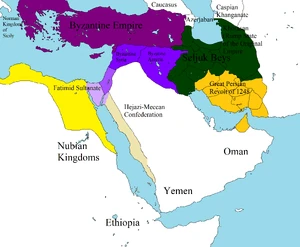
Byzantine gains in the Near East.
In 1134, the Byzantine Emperor Alexios II Diogenes launched a full-scale invasion of the Fatimid Caliphate with the goal to seize the Arabian portion of the empire, specifically Jerusalem, the Sinai Peninsula, and Mecca and other holy cities in Islam. The Fatimid Empire was already in rapid decline due to the weakening of the Fatimid political system as a result of drought and the army, and the Iqta system unintentionally granting more autonomy towards the fringes of the Empire. The Byzantine invasion finally broke the pressure, and in the ensuing chaos, the Red Coast and the Fatimids native homeland, of Algeria, split off, forming the Hejazi-Meccan Confederation and the Sultanate of Algeria. Tunisia later split off as well, forming a mercantile kingdom that came to a critical part of the Mediterranean trade. The latter two would later be reincorporated into the Fatimid domain, but that actions would lead to its collapse.
The Fatimid Caliphate finally collapsed when the Normans invaded North Africa. So weak the caliphate was that in soon crumbled and descended into Civil War. The Norman King of Sicily, King Roger II, now had a sizable vassal state stretch from Constantine to Tripoli.
After a few decades of internal squabbling, a local Nubian noble, Basilike, was invited to the Emirate of Aswan by Emir Humaidaan el-Malik after losing a civil war to Luwai al-Shakoor in 1172. Humaidaan el-Malik won his throne back, but was ill with cancer, and became a puppet of Basilike. el-Malik succumbed to cancer in 1179, and Basilike seized power. His conquests were brief and by 1181, Egypt was unified under the new, Coptic, Basilikean Kingdom. Nubia was integrated into the realm in 1183, and small exclaves of the now splintered Hejazi-Meccan Confederation were subdued in 1185.
The conquests of Basilike I was worrying affairs in Constantinople. Emperor Andronikos III at first attempted to resolve the issue diplomatically, bribing Basilikean officials and Basilike I himself and establishing an alliance between the two. In 1190 however, when the Hejazi-Meccan Confederation reunified under Emir Razeen el-Baig, the Byzantines marched down and sacked Yanbu, the capital. Worried of the geopolitical effects of a seizing of the Red Coast, King Basilike I rushed to occupy what remained, and conflict ensued. The two met at Sharm El-Sheikh in 1191, where the comparatively inexperienced Andronikos III was decisively defeated by the outnumbered Nubian forces. The Nubian King continued to campaign in Byzantine Syria and Levant, killing Andronikos III... and himself at the Battle of Tripoli in 1192. The battle nullified all his gains and a white peace was established. in 1193. His successor, Aggelos I, was only 10, and so his mother, Ajola of Khartoum reigned as regent and, knowing how incompetent the Nubian military leadership was, signed a white peace with emperor Andronikos IV.
In Iberia, King Alfanso's revolt is brutally crushed. This results in a unified Iberia.
Meanwhile, after being defeated by the Lombard League in 1176, Fredrich Barbarossa, emperor of the Holy Roman Empire, without leaving and dying in the Third Crusade, attempted once more to subjugate the City-States of Northern Italy. The Italians again slightly outnumbered the German forces and the two belligerents met at Pavia, just 20 miles (30 kilometres) south of Milan. The Germans won the Battle of Pavia due to the misunderstanding of commands made by the Italian Commander Argo Vaccarello. The conquest of Southern Italy isolated the Pope in his territories in the Papal States and this combined with the wealth received from Northern Italy would allow Fredrich to crush the rebelling Dukes of Northern Germany, allowing the Empire to remain a united and centralized force. The emperor marched to Rome, installing his Anti-Pope. This effectively made the Papacy a territorial domain of the HRE.
In 1198, the Kingdom of Africa split off from the Kingdom of Sicily upon the coronation of the new Holy Roman Emperor, Fredrick II Hounstafen in 1197. This was the result of the consequential inheritance of Southern Italy as a result of his crowning.
13th century[]
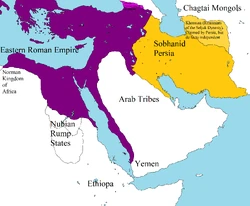
The Middle East by the end of the 13th century.
As the 13th century dawned, a succession crisis was developing in Byzantium. Emperor Nikephoros IV's tyrannical actions led to his deposition by the Byzantine Army in 1204, who installed Theodore I Laskaris. A member of the Byzantine Bureaucracy, Romanos Kurkua, overthrew Theodore I, but was in turn deposed by Nikephoros IV, who had escaped from imprisonment. Nikephoros died in 1218. Having beheaded his wives due to her presumed inability to bear a male child, he died heirless. The Roman Senate, though virtually powerless, declared his eldest daughter Marie, who they saw as a cunning, capable, and beautiful woman, as his heir. This caused a civil war, however, as Nikephoros's 17 other daughters claimed the throne leading to the Princesses' Feud, a Civil War that lasted from 1218-1224. The 23-year-old Marie I was triumphant, beheading all 17 of her sisters and marrying a Pontic General, Constantinianus Melodus.
As a ruler, Marie was a capable ruler. The retaining of Anatolia and extra manpower meant that the empire was less reliant on mercenaries and thus had far more wealth in the treasury. Marie used this wealth to her advantage. She knew of the power of education and was quite concerned about her subjects. She had heard of the idea of the university, an institution that was being established in places such as England, Bologna, and Morocco. She established the University of Constantinople in 1227. Marie also constructed the Royal Library in 1234 and wrote close to forty books covering a range of topics ranging from science to history.
The Mongols stormed the Middle East in the early 13th century, invading the Byzantine Empire from the Middle East in 1222 and again from Europe in 1242. The Mongols invaded and conquered Assyria and Syria (minus Antioch which, as a centre of Christianity, was fiercely defended by the Byzantines).
The Emperess also waged war with the Hungarians and the Holy Roman Empire. Invited by the local nobility to aid them in their efforts of freeing Southern Italy, the Byzantines seized Sicily and Apulia. The Byzantines had these territories before and had a vested interest in the region. The local nobility, enraged by this betrayal, revolted in 1234 and 1235 and due to the Byzantines being preoccupied with the Mongols, were triumphant, thought the state soon became a decentralized collection of bickering and warring states, allowing for the Byzantines to decisively defeat them after mailing the Mongols in 1253 at Tikrit and Varna.
The HRE, by far the most powerful state in Europe, invades Pisa and Venice. Venice had several colonies in the Adriatic and due to geography and the empire's lack of a navy, these colonies would become independent duchies. This resulted in the formation of the duchies of Dalmatia, Ragusa, and Istria. The Byzantines had eyed the Venetian possessions on the Adriatic coast, being the Venetian's main maritime and mercantile rival, and like Southern Italy, had a vested interest in the region. So they immediately invaded, which added more tension between the Holy Roman Empire and the Eastern Roman Empire.
In this era, we saw the movement of Germans into the Baltics. The Teutonic Knights led the charge, but in this timeline, since the HRE is much more centralized, they are simply vassals of the Holy Roman Emperor. This huge growth of Germans on their border would result in the Poles fighting endless wars of survival, which due to the greater military culture of Germany and the sheer population of the HRE would ultimately fail. By the end of the century, most of Poland would be annexed into the already enormous HRE, while the remnants of Poland would be a decentralized collection of squabbling and bickering duchies.
In 1271 the Mongol Il-Khanate was overthrown by the Persian revolt of 1271, under the leadership of Shah Ramin Sobhani of the Sobhanid Dynasty, the first Native Persian dynasty to rule Persia since the Arab conquest and would rule until the invasions on conquests of Tamerlane. Tensions were high with the Byzantines and Emperor Andronikos V waged two wars with the Persians between 1281 and 1296.
During this period, a series of unpopular policies and incompetent and unskilled leadership lead to the rapid decline of the Nubian Empire (by now no longer ruled by the Basilekean Family). The Byzantines sacked Cairo in 1289, carving up Egypt, while a few rump states dotted the south.
14th Century[]
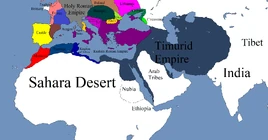
The world in 1400.
By the 14th century, the Byzantine Empire was at its second height, only behind the days of Justinian. Stretching from Croatia to Assyria and from Cherssenon to Egypt, the empire was prosperous and powerful, projecting its influence across the region.
The Empire was highly populous as well. Constantinople alone was home to around 1.5 million people, and the empire itself had a population of around 20 million. This was the beginning of the Κίνηση (Kínisi), which is Greek for movement. From the 14th to 20th centuries, tens of millions of Greek settlers settled in areas such as the Middle East, Balkans, Italy, Crimea and the Caucasus, as well as other soon to be Byzantine territories.
However, for now, the overpopulation of the Byzantine homeland was beginning to become a major issue in the empire. The farmers of Anatolia just could not keep up with the rising demand for food, leading to rampant food shortages in cities such as Athens, Adrianople, Antioch, and of course, Constantinople. This culminated in the 1320s. At the beginning of the decade, worrying reports told of crop failures big enough to wipe out 20% of the Anatolian food production. In a desperate panic, Emperor Constantine XIII summoned a meeting with the Byzantine Senate in 1323, who suggested the implementation of food rations. Constantine XII agreed and this played a major role in what was called the Restoration of the Senate that would continue until the end of the 15th century.
The climax of these food crop failures came in 1325, when the new emperor, Theodore II, received reports that stated that between 75-90% of the Anatolian crops had failed. According to The Chronicles of Rome, by Demetrius Staurakius, when the emperor heard about this, he froze and became as pale as the heavens. He immediately ordered the primary source of the empire's food supply to be moved to Egypt, which was once the breadbasket of Rome. However, due to negligence from the Nubians, the agricultural output of the region was simply not great enough to support the swelling population of the Byzantine Empire.
Thus began the Long Famine, also known as the Devastating Famine. It is estimated that about 50% of the empire's population perished through these difficult times. The situation was made worse by the Famine Wars, where Hungarians, Persians, Nubians, and Mongols circled around the empire to feast on the empire like crows. Large Swaths of Egypt were conquered by the Nubians, Assyria was forcefully taken by the Persians, and Croatia and Bosnia were conquered by the Hungarians and the Golden Horde invaded Crimea in 1337.
The Mongols besieged the city of Kaffa, a critical Byzantine port. Like in OTL, a few Mongol troops are infected with Bubonic Plague, are launched into the city, news reaches Constantinople detailing the annihilation of Kaffa by merchant ships that carry rats and fleas. A further 2 million people perished, though the plague ad the unintended side effect of saving the empire due to plague outbreaks in enemy nations. The entire empire was in shambles, which was worsened by a civil war that ensued after the entirety of the Diogenid Dynasty succumbed to Bubonic Plague. The Kommenids came to power briefly in the mid 14t century, but their unpopularity led to their overthrow in a coup d' eta by Theodore Caerularios, who established the Caerularian Dynasty that would rule Byzantium until the early 17th century.
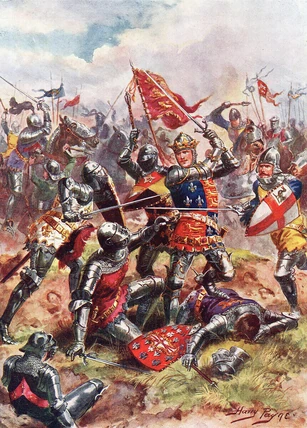
Assault on Paris (1376) by the English artist Marcus Smith.
Meanwhile, the HRE, being such a powerful force to be reckoned with would attract many enemies. The only two that could face the might of the empire were the Byzantines and the French. With the Byzantines reeling from the death and destruction from the Long Famine and Black Death, this left France as the only adversary of the empire. Fortunately, the 30 Years War (OTL's Hundred Years War) was raging between France and England, so the HRE allied with the English and crushed the French at the Battle of Meaux in 1376, opening the gateway for an occupation of Paris.
Meanwhile, the Byzantine empire was recovering from the death and destruction of the early 14th century under the combined 40-year reign of Theodore III and his son, Thomas III. The population was mounting and stability was returning. Wallachia and Moldavia were made vassals and would remain so up until the 20th century. Some scars persisted, but the Empire was recovering.
Then, Tamerlane happened.
In the 1390s, tens of thousands of Timurid troops poured into the Byzantine Empire. Within five years, all of the empire's Middle Eastern possessions would be lost to the Chagatai Invaders. The Timurids besieged Constantinople in 1396, but the Byzantines held them off, pushing them back. Timur died at that Battle of Sinope in 1397, along with tens of thousands of Tiumurd soldiers. Maurice signed an armistice with the Timurids in 1398, attempting to recover from the empire's losses and make preparations for future conflict. In that year, he was infamously assassinated by a Timurid diplomat, leading to future conflict in 1400.
During this period, a series of cultural exchanges between the Byzantines and Italians made way for the Renaissance...
15th Century[]
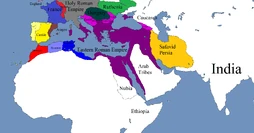
The Mediterranean world in 1492, the year the Age of exploration began with the colonization of the Canary Islands.
The collapsing Timurid Empire collapsed into bickering and warring factions following a defeat from the Byzantines at the hands of Thomas III's bitter and vengeful son, Thomas IV. This disunity allowed for the new emperor to conquer and subdue what the empire had lost in the decade prior. The seizing of these lands was marked by the official start of the Κίνηση as Greek settlers began to move in
Maurice died suddenly in 1408 while riding his horse. Prior to this, he had organized a royal marriage between his only child, Paulina, with the son of a local Hungarian Duke following a brief war with Hungary in 1404. Paulina hesitantly became empress, only to fall victim to Hungarian attempts to influence her to indirectly prop up Hungarian interests. Paulina was not interested in ruling, so she abdicated in 1411, leaving the throne to Szekeres Zsombor. The Byzantine Nobility were furious and so overthrew Szekeres in 1412, causing a decade long conflict that the Byzantines were ultimately triumphant. The Bosnian War (named after the area most of the battling took place) severely weakened Hungarian hegemony in Central and Eastern Europe as well as its centralization and economy, paving the way for more upheaval in the late 15th century.
Meanwhile, the English were beginning to lose their hold over France. The English possession of France was always tenuous at best. France had over three times the population and was never loyal to the English crown. Frenchmen resented the English Settlers who took and raided their land and the English nobles who raised taxes on them and treated them as subhuman, second-class citizens. The scrutinized the court in London and longed for independence. Revolts and massacres were abundant, culminating in 1429, when Joan of Arc (with support from the Holy Roman Emperor who were wary of the English challenging their status as the predominant power in Western Europe) rallied her people and drove the English out of France. She claimed to be spoken to by angels and according to her, they said that she should lead France to greater heights. She interpreted this as a command to rule France and the French people, aroused by her bravery, crowned her queen in 1436. This raised some eyebrows since Joan was of a present background, but fortunately, the royal courts of Europe were too distracted by internal and external affairs to object.
Queen Jeanne I of the new Romée Dynasty detested the HRE for their involvement in France's subjugation. In 1441, she launched a campaign into Germany with the goal of pushing France's borders to the Rhine. The Holy Roman Emperor, Rudolph VI of the House of Luxembourg, was enraged that this peasant girl dared to wage war with him and subsequently led an army to defeat her. Joan won a few key battles in the early years of the Rhine War, but After some defeats in the Lowlands (during which, English Pirates raided the Coasts of Aquitaine and Normandy), the two met in Nevers. The treaty signed saw France's borders grow significantly, though not all the way to the Rhine. Burgundy was established as a buffer state between the two great states. The two leaders also agreed to launch a joint crusade against the Hussites.
The Age of Discovery does not commence until the final years of the century due to the Byzantines accepting Western European Merchants to the Spice Trade and other Asian markets, thus creating less demand for a route that bypasses the trade restrictions. However, naval technology was making great leaps forward, and so Europe would eventually start exploring the fringes and the uncharted simply because it could be done.
The Reconquista still occurs and still results in a Muslim defeat with the only difference being that Castile has three Junior Partners: Portugal, Galicia, and León.
Meanwhile, the Renaissance occurs in Europe. Byzantium, Italy, and (though to a lesser extent) Germany all experience a flourishing of the arts just like how Italy did in OTL. Many great artisans, such as Leaadrdo Davinci, German artist Benno Roemheld, and the Byzantine writer and artist, Agnellus Stratioticus, come out of this rebirth of European culture.
Few people are aware that Islam almost had its very own reformation. In the 15th and 16th centuries, there was a rise of Sufi and Shia reformists across the Islamic World. They were promptly shut down by the Ottomans who feared that religious strife would tear their empire apart. Without the Central Ottoman authority from Istanbul stomping the movement, it would mean that Islam would have had its own reformation. The central question in the Middle East was how to deal with Byzantine Hegemony over the region. The more tolerant Sufis believed that the Empire's presence, or at least the threat posed by it to the Islamic world, be expelled by relatively peaceful ways, while the Shia fanatics argued for a Jihad against the Romans. In the end, conflict ensued. Hundreds of thousands (in rare cases, even millions) died in the fighting. The Byzantine Emperor, Leo VIII, sends armies into their Middle Eastern possessions and impose an inquisition like system, forcing Muslims to convert to Christianity. This only strengthens the Shitte Argument. They win the argument and in 1493, form the Barian Caliphate. Their aim: to expel the Christians from the Middle East. The First Jihad had begun.
16th Century[]
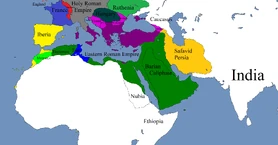
Mediterranean World in 1510.
The newly reincarnated caliphate began its mission of seizing Byzantine lands. Once again, the empire was losing its grip over its Muslim populated possessions.
John III and Michael VIII, the co-emperors of the empire, dispatched troops in the Arabian peninsula, meeting the Muslims at the Battle of Al Hadithah. The Byzantine general, Maximus Kerularios, was decisively defeated and taken captive by the Arab general Rushdi el-Akhtar in 1503. He was beheaded the very next year.
On August 5th, 1504, Muslih, son of the first Barian caliph, Waatiq el-Bari (who had suffered a greatly mourned death two months prior), delivered a speech at the Congress of Mecca, decrying the supposed sins of the Byzantines and declaring all infidels to be enemies of Allah, demanding that they perish. The subsequent time, known as the Slaughter of the Near East, saw the massacres of millions of Christians, Jews, and other religious minorities across the Islamic World. This intensified resistance against the Muslims. Do not let the map fool you, for plenty of revolts broke out throughout the Caliphate.
The Kingdom of Tunis (formerly the Kingdom of Africa), by now heavily Christian due to three and a half centuries of Norman Rule, was invaded in 1507, followed by the vassalage of Morocco, who declared war on the newly formed Iberia. Muslih himself met the Iberians at the Battle of Ceuta in 1509. were he was decisively defeated and killed. His death allowed for the fall of Morocco to the Iberians and the beginning of the end of the Barian Caliphate.
In 1509, Antioch was sacked, with its population genocide and raped. The Muslims advanced towards Constantinople. The new Caliph, Muslih II, looked at Constantinople with vengeance, as it was where the Arabs were soundly defeated at the 718 sieges of Constantinople. Fortunately, the use of gunpowder weakened the walls as cannons battered the old Theodosian Walls. However, winter came and weakened the Arabs, allowing the Byzantines to rout them at the Battle of Nicomedia from December 19-20.
With the Iberians, Tunisians, and Byzantines closing in on the Caliphate, Persia dropped out of the conflict and persecuted reformist Muslims (to no avail, which was shown a coup d'etat two years later). Alexandria was recaptured in 1512. In the chaos, several Arab governors of former Byzantine lands surrendered to the Romans, which enraged Muslish II, who died leading a last stand at the decisive Battle of Jeddah. His son, Muslish III, was only four years old. Soon, the Caliphate collapsed.
Meanwhile in Germany in 1517, a monk named Martin Luther nailed his 95 Theses on the door of the Wittenberg Cathedral (as the legend says). After being questioned by the Papacy, becoming radicalized, and being deemed a heretic and excommunicated by the church, Martin Luther spreads his message with a translated Bible, allowing the common folk to understand the texts of the Bible, sparking the Reformation.
The Holy Roman Emperor, Maximilian III of the House of Luxembourg despised the pope, who, due to negligence by the German and Northern Italian focused Holy Roman Emperor, had been able to run amok and expand its power. He sought to curb the influence of the pope, and thus, declared Lutheranism the state religion. By this time, the sect had spread through Denmark and Northern Germany, so this appeased the Northern duchies while infuriating the region of the empire around the Alps. A civil war known as the Reformist Feud ensued, plunging the empire into internal strife and upheaval for the next twenty years.
Hungary, after undergoing a rapid decline in the latter half of the 15th century, undergoes a nearly revolutionary change that brings the state back to greatness. They expand their borders, specifically towards Byzantium, who had just wrapped up exhausting wars with the Arabs. The Keroularid Dynasty is nearly overthrown in a brief civil war.
A Genoese merchant, Bartholomew Corombo, under orders from his older brother, Cristoffa Corombo (now deceased), sponsored by the English government, sails west across the ocean, landing in Newfoundland in 1506. Believing he was in Tartary (Mongolia), he sails further south, searching for Japan and China. He landed in the Bahamas and assumes its Sepengu (Japan) and after running aground in Korea (Florida), hit the Aztec Coasts in 1507. After sailing along the coast for a longer period than expected, he concluded that this is not Asia but instead an entirely new landmass, Columbia (named after the English pronunciation of his surname, Columbus). He sails back bringing the news to the English court. Amazed and impressed and wanting the riches of the Aztec Empire told by the Colombo and his crew, the English send Bartholomew back to what they called Mexica. They conquered the growing in 1509, and he was declared governor of Mexica the following year, while several others governed the various English colonies such as Henria (Bahamas), Avalon (Cuba) Vineland (Newfoundland), New Cornwall (Florida) and New Bristol (Cape Charles)
The Iberian king, Ferdinand I, previously having denied Cristoffa's offer due to war with the Arabs, send his brother, Giacomo west. He had some business to conduct in Sao Tome and originally set sail for there. However, to sail past the Cape of Good Hope, one cannot hug the sea as it appears, but instead has to venture out deep into the Atlantic due to the ocean currents. Giacamo ventured too far west and landed in Brazil (Brasil in Iberian), similar to how the Portuguese landed in OTL. Brasil does not have many natural harbors, so the Iberian presence was initially minuscule. However, by 1600, they had expanded and had even conquered the Inca Empire as a result of the English being too far from Cuzco.
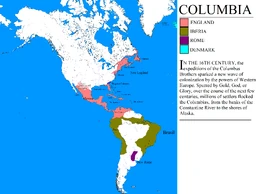
The Columbias in 1600
Meanwhile, in the 1550s, the Bavarian House of Wittelsbach won the Reformist's Feud and began to crack down on Protestant rights. This created resentment among the empire's Protestant population, as well as most of Germany due to the seeming carelessness the emperor showed to Germany, the heartland of the empire, while they meddled deeply in the affairs of Italy. In 1591, things came to a boiling point with a massive Protestant uprising that would launch one of the deadliest and defining wars in European history...
17th Century[]
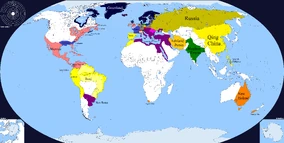
The world in the year 1700.
After a series of incompetent and unskilled emperors, Hungary comes under the imperial occupation of the Byzantine Empire in the Byzantine-Hungarian War of 1609-1611. Byzantium itself has come under the leadership of the Wallachian Molivesti Dynasty under Emperor Simeon I, a dynasty that ruled from the death of Isaac II in 1602 to the present.
The English, Iberians, and now the French (Huguenots and "Colonie commerciale de la Louisiane") and the Danes, Swedes, Byzantines, and Germans, have been expanding their presence in the Columbias. The gold output from Mexica and Andeasia (Peru) facilitated the rise of Iberia and England's wealth in the coming centuries, particularly Andesia, as it's gold and silver mines were far more superior to those of Mexica, making it an English goal to seize the colony.
Meanwhile, the HRE founded a few scattered colonies as well as France. Government sponsorship of these colonies was scarce due to conflict in Europe, speaking of which, the refuges from this war were thus the main demographic to settle and populate these colonies.
They were fleeing from the 80 Years War, a continental conflict facilitated originally by disunity amongst Catholics and Protestants but later was fought over retaining the status quo or establishing a new continental order: have the HRE be united into a powerful, centralized force, or have it be splintered into numerous small, bickering states that would balance the balance of power on the continent. The latter occurred and Germany was divided into thousands of squabbling states that essentially wiped out the original power of the empire. Despite this, some colonies were founded by the empire, but with the empire's decentralized and complex nature, they too became decentralized bickering states.
The Byzantines and Muscovites fought for control of the Tartar/Crimean/Cossak grasslands of the area around Crimea. The cities of Crimea were Byzantine clients states, if not effective proper Byzantine territory. From there, the Byzantines spread Greek settlers across the steppe, while East Slavs moved from the Ukraine down south.
While on the topic of Russia, it is important to mention they, with the Byzantines as a historical role model, would not westernize. However, the Byzantines being connected to the Mediterranean and being on par with the monarchies of Western Europe would mean that Russia (or Muscovy as the continued presence of the Byzantine Empire would delegitimize any Russian attempts to initiate the policy of "Third Rome") would still be dragged out of the dark ages if faced after the Mongol subjugation.
During this time, one of the greatest Byzantine rulers came to the throne: Empress Apollonia. Her reign saw the empire reach its height, and the reconquest of Rome in 1684. Her skilled rulership, as well as those of the following emperors, led many to place the House of Molivesti as being one of the best dynasties of Rome.
The continent of Janzland (Australia) was discovered accidentally and unknowingly by Willem Janszoon. In the latter half of the 17th century, the Dutch would begin to colonize Janzland and the South Island of New Zeeland (New Zeland), which was denoted as Oranje Isle.
18th Century[]
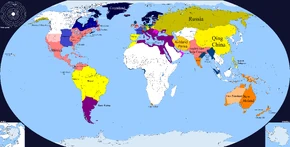
The world in the 18th century.
In Europe, the 18th century began with a bang. After a plague outbreak in Iberia, the Iberian Trastámaran line expired. In the midst of the devastating epidemic. King Ferdinand IV left the throne vacant, and soon a scramble over who would sit on the Iberian throne. Two factions formed: the French Faction who wanted Francis, Duke of Brittany, a member of the ruling French Romée dynasty (and later the Louis Charles de Lévis after it was discovered that Francis was having an affair with the daughter of an Iberian nobleman) and the Byzantine Faction that wanted a personal union between the Byzantine Empire and the Iberian Kingdom. Though Europe only had less than twenty years of recovery from the 80 Years War, the continent was already off to war once more.
In the end, Basilea Apollonia was given the rights to the Iberian Crown by the right of conquest. Meanwhile, Louis Charles overthrew King Louis XVII, establishing the Lévian Dynasty in France.
With this war, the story of later Early Modern European politics would centre around the Byzantine Question, the goal to balance the power of Europe by undermining the power of the empire. The Second War of Prussian Succession, from 1733-1739, and the war of the Scandanavian War of Succession, from 1741-1749, despite their namesake, were primarily a balance of power war aiming to dethrone the Roman Empire as the predominant power on the continent. This came to a head in the Twenty Years War (1753-1772). Originally sparked by England's long sought after goal of seizing the Iberian holdings in Columbia (Iberia revolted successfully with foreign aid during a Byzantine Civil War), the center of Iberian power and wealth, the center of the conflict moved to Europe, with heavy fighting in Byzantine Hungary and Austria, which was in a union with Bavaria. Ultimately, under Emperor Angelos I "The Conqueror", the Byzantines were able to hold their own, though the costs of the war placed an especially heavy burden on the Byzantines, while their rivals were empowered, as their military had been disciplined, hardened, and had utilized new military tactics effectively.
The exception was Bavaria, which had its infrastructure and economy decimated in the wars. After a war in the 1780s with Byzantium (which famously saw the marriage between Byzantine Prince and future Basileus Georgios I and the Bavarian Princess Maria Antonia), a series of events led to the Bavarian Revolution (the premise of which is based upon the fact that the issues pre-revolutionary France had been ones that all of Europe had, just that France had the worst and that Bavaria would be the next powder keg to explode). After the overthrow of the monarchy and the forced execution of thousands of nobles, and the near execution of the royalty (who fled to Byzantium due to Maria Atonia's presence), the revolutionary government began to seek to spread the revolution far and wide. This failed due to Bavaria's central location, the increasingly inferior military culture of Bavaria when compared to its foes (particularly Byzantium, France, and Prussia), Bavaria's devastated population, infrastructure, and economy, and the fact that the country was still embroiled in a civil war.
Meanwhile, similarly to how things were in the 17th century, the English, Scottish, and Dutch declared a state of neutrality, with the Scots and Dutch attempting to challenge the English, who had been the predominant colonial power since the 16th century, establishing trading posts/ colonies in Malaca, and the Cape of Good Hope.
19th century[]
Unlike OTL, with France not undergoing a revolution and with Bavaria getting crushed when it flirted with the idea of a revolution, the begging of the 19th century would be relatively peaceful in comparison. This doesn't mean conflicts are scarce: there was a major European conflict (if not global conflict) on average every 10-20 years, and without the Napoleonic Wars throwing everything into chaos and mayhem, as well as the 1815 Congress of Vienna established a new continental order, this cycle would continue relatively unhindered for quite some time. More balance of power conflicts would be commonplace: for example, the 1810s saw the Saxon War (often confused with the Saxon Wars of Charlemagne), caused by worries that Saxony's continued influence over central Germany would upset the balance of power. The result, an incomplete victory for the Saxons, would weaken the imperial position even more as the emperor continued to lose his influence and importance within his very own realm.
As said, the issues that led to the French Revolution were issues that all European monarchies faced, it was just that France had the worst. With the Bavarian Revolution being nowhere near as Earth-shattering as the French Revolution, the idea of a revolution isn't as revolting as in our timeline, and so all these internal issues Europe faced would continue to brew unhindered until the Revolutions of 1821, this timeline's replacement of the Revolutions of 1848.
The countries/regions more disproportionally affected were France, Germany, Italy, and Byzantium. All of these countries had no colonies (or in the case of the last one, no easily accessible colonies [France lost their Louisianan Colony to the English in the Saxon War), meaning that the most radical members of society remain in society, becoming more resentful of the seemingly ancient order. France saw the overthrow of the monarchy, and the establishment of the French Republic, while the power of the Roman Senate was acknowledged as being an integral part of the Roman government, something not true since the days of Diocletian. This reversed the Apollonian Doctrine, which famously stated that-
"The Emperor is the Government."
and effectively established a constitutional monarchy in Byzantium. However, the emperor, being so significant to the very cultural and political identity of the empire, retained an unusual amount of power when compared to monarchs of other constitutional monarchies.
Perhaps these two are minuscule and insignificant when compared to what is universally recognized as the two most important revolutions, the German and Italian Revolutions. The Italian revolution, with a young, charismatic, but naïve Macario Calderaro as its figurehead sought to officially remove imperial influence and possession of Italy, both from the HRE and Byzantium. With the complex and decentralized nature of the Holy Roman Empire, the city-states of northern Italy, discontent with Imperial rule, obliged, unifying northern Italy. The Kingdom of Italy was prematurely declared in Milan in 1822, with a Savoyard Noble, Ernesto I of the House of Vescio, as the first king of the newly formed kingdom and with Calderaro as Prime Minister.
Next, they pursued the Byzantine holdings in Southern Italy. However, with Byzantium's more centralized structure and with the local nobility favouring the Byzantines over their Italian brethren due to centuries of appeasement, bribery, and flattery by these Byzantines so as to acquire their loyalty, this proved to be much more difficult than expected, and endless wars would ravage central Italy as the two fought each other for control of Italy.
Meanwhile in Germany, the failure and humiliation inflicted upon the Wittelsbach were simply too much to bear. In 1821, after Emperor Josef IV's death, the Electorate of Saxony, furious by continued Bavarian intervention in Saxon politics and influence, vowed to cast their vote for Wilhelm von Luxembourg, knowing that the House of Luxembourg had great disdain for the Bavarians, and longed to return to the times where they were the emperors of the empire. Several other electorates who detested the Bavarians, joined the Saxons ad swore allegiance to the new Emperor.
The new emperor was not the emperor everyone was expecting. He cared little about politics and often left political affairs and squabbling to the minor duchies and kingdoms. He was reluctant to even accept the offer of emperorship and only after constant begging and bribery did he hesitatingly accept his position. Now to the states of Germany, who had long enjoyed relative autonomy and independence from the emperor, this was not really an issue, however, to a growing group of nationalists in the empire, this outlined everything that was wrong about the Holy Roman Empire, which was not Holy, nor Roman, nor an Empire. The radicals of this movement used this as a justification for a revolution. On November 17th, 1821, a group of nationalists stormed the emperor's palace in Luxembourg City, taking the emperor captive. Waldemar Bennewitz, the leader of the Nationalists, proclaimed the German Nation in on that day.
The states (besides the staunchly nationalistic west) were enraged. They knew that the Nationalists aimed to centralize the German states, thus dismantling their autonomy. The King of Prussia, Fredrich III, along with other major states, declared a state of war against the revolutionaries. Thus, the German Civil War began.
After a decade of fighting and foreign intervention, the Nationalists won and crushed the Imperialists. However, the newly formed Germany already began to destabilize. The Nationalists were split between if the government should be a Republic or a Monarchy. Bennewitz never specified, as this was already a fairly contentious issue, and wanted the revolution to succeed rather than fall apart due to petty internal quarrels. Civil War erupted again, this time between Republicans and Monarchists. The Monarchists won in the end, electing Wilhem, Duke of Hanover, as Kaiser of the Germans.
The integration of the Netherlands into Germany and the collapse of the Scandinavian Empire due to its humiliating defeat at the hands of the Germans was capitalized by the British as an excuse to scramble and annex the Dutch and Scandinavian Colonies. The English seized Christian's Land and Dutch India, while the Scottish seized Dutch Indonesia.
Meanwhile, the effects of industrialization, beginning in the mid 18th century, began to show its mark. Virtually all nations industrialized during this period, increasing economic and technological productivity. Perhaps a major side effect was the increased casualties shown in conflicts. Italian Giovanini Guns (Gattling Guns) decimated Byzantine riflemen. French railways deposited supplies to French troops in Germany. Scottish Ironclads battled with English Dreadnoughts. This would pave the way for greater conflict in the 20th century.
The Imperialiation of Africa commences with the widespread availability of Tonic Water in Dutch Indonesia. It isn't too distinct from OTL with the only difference being that Eastern North Africa falls into Byzantine lands, Scotland colonizes West Africa and Cameroon, and the Germans colonize much of Southern Africa. The Suez Canal is completed in 1871, shortening the distances needed to get to the southern and eastern shores of Asia.
Inspired by the Italians and Germans, the ethnic minorities of the Byzantine Empire sought to establish an independent state for themselves. After a Bulgarian revolt was brutally crushed by the Byzantines, support for these movements skyrocketed, and the massacre of ethnic Slavs also hampered relations with Muscovy. After a Serbian uprising was crushed in a horrific manner, the Muscovites (who were experiencing a rise in Slavic nationalism) invaded the Byzantine empire in an unprecedented shift of diplomatic relations. The Byzantines, who were fighting the Persians, were completely unprepared for war with the Muscovites, and were humiliated. The Treaty of Moscow, which ended the war, saw the recognition of Hungary, Slovakia, Transylvania, Romania, Serbia, Montenegro, Croatia, Bosnia, Albania, and the Byzantine possessions in and around Crimea (though after considering the ramifications of such an act [since Crimea was populated by Greeks] this demand was dropped). In an unprecedented move, the emperor, filled with humility and shame, accepted. Huge chunks of Byzantine land were ended to newly independent states, and the empire became a laughing stock. This also allowed the Italians to finally seize the rest of Italy.
The empire was humiliated, and it sought revenge...
20th century[]
With the idea of the balance of power not dying out with the end of the early modern period, 19th century Europe would be no stranger to continent-wide conflict, a great shift from OTL. Convoluted conflicts such as the Schleswig War, the Burgundian Revolt, and the Third Franco-Spanish War profoundly shape the course of 19th-century European demographics, politics, and history.
With the end of the Prussian War in 1897 with the Treaty of Worms, the stage was set for future conflict. The war had been sparked by border disputes along the Russo-German border, particularly the eponymous region of Prussia. The peace treaty more or less established a Muscovite victory which allowed it to solidify itself as the dominant power in Eastern Europe, usurping that position from the severely weakened Byzantines. This was problematic as previously, Muscovy had been seen as an impoverished, barely European and civilized nation on the fringes of the continent, but with the capabilities of Muscovy being shown in the war, this forced the European powers then to recognize that Muscovy was a power to be reckoned with, and this, combined with Muscovy's sheer size began to worry certain European powers.
Furthermore, despite the Muscovite gains in the conflict, the government in Petrograd (formerly known as Saint Petersburg but renamed to appear less German) was still unsatisfied with their gains and the ramifications of the conflict. Their aggressiveness would lead to the Winter War between it and Finland. After some fighting, the war was ended due to conflict with Japan, which unlike in OTL, resulted in a Muscovite victory. Japan's defeat furthered hysteria and anxiety over Muscovy's growing influence.
In 1912, Muscovy resumed their conflict with the Finns in the Scandinavian War. This time, the Finnish had aid from the Leauge of Kalmar: Sweden, Norway, and Denmark. The Muscovites unsurprisingly performed well, but this raised concern from the courts of Europe. When the Muscovites besieged the Swedish capital of Stockholm, the Germans, Iberians, and English issued an ultimatum, warning the Muscovites that they would wage war with them if they did not-
"widthraw their men from the forests of Sweden and Finland, and the mountains of Norway."
The Muscovites refused (to no one's surprise) and war ensued. The three countries declared war on Muscovy in 1913, expanding the war's scale.
With all their enemies at war, many Frenchmen clamoured for a French entry into the conflict. The French parliament refused, however, due to the fact that this would mean that France would be fighting a two-front, if not three-front war. Thin enraged many Frenchmen. France was undergoing an extreme nationalistic cultural revolution, and the common Frenchmen thus detested France's rivals. The government's refusal to wage war led to the Restoration of the Monarchy, and uprising which saw the return of the French Monarchy and the installation of the House of Borbón. The new government sought closer ties with Scotland and Italy, enemies of England and Germany respectively.
The French and their allies declared war on the Kalmar Leauge. Despite fighting on two-fronts and having their Atlantic ports blockaded, they performed relatively well. The Byzantines meanwhile, bitter over their defeat at the hands of Muscovy, declared war on Muscovy, calling in all the South Slavic states.
After about 14 years of fighting, the Muscovites were defeated. The Treaty of Azov saw major territorial concessions made by them and the French. Additionally, Serbia, Bulgaria, and Albania, the three most rebellious provinces of the Byzantine Empire. Additionally, Southern Italy and Rome were granted to the empire, and the Byzantine vassalage of Croatia, Bosnia, and Romania was recognized as well (They did not vassalize the Hungarians since that would upset the balance of power). Regardless, their thirst for vengeance for the Russo-Byzantine War was satisfied. England also forcefully annexed Scotland, forming the Kingdom of Great Britain
The Scandinavian War saw the first major implementation of Biological Warfare, Aerial Warfare, submarine warfare, and trench warfare (this was not the first time these were implemented, and first saw their debut in the Prussian War). All these methods of warfare culminated in a truly devastating conflict that destroyed Europe. 1930s Europe was a place of economic and political turmoil. Columbia prospered, since both Spain and England assisted each other in the conflict, leading to economic and cultural flourishment, in addition to mass immigration to the two continents. This also established a separate cultural identity between the colonies and the central authority in London and Toledo. The colonies soon began to yearn for independence, paving the way for greater conflicts in the mid 20th century.
The ethnically Manchu Qing Dynasty was overthrown in a popular revolution similar to OTL in 1912. The deviating point from OTL is that with Republicanism being a more fringe belief (without the U.S and with many republics being partial republics or republican only in name), the Chinese would preserve imperial rule in China, establishing the ethnically Han Xi’an Dynasty. They began to implement reforms, attempting to make China into a well-respected nation.
By the 1940s, war once again seemed to loom over the continent. The Muscovite House of Romanov was overthrown by the House of Yanovich, who promised to return Muscovy back to glory, and the Second French Republic wanted a rematch against Germany. The Iberians saw their minor gains from the Scandinavian War as unsatisfactory and were enraged. A coup d'etat ousted King Henry VIII and installed a republic. The Muscovites invaded the Caucasian states, then proceeded to re-annex Ukraine and Belarus.
Finally, in 1951, the Muscovites invaded Poland. By now, Europe had somewhat dragged itself out of the mire a dropped itself in in the Scandinavian War and the Germans offered aid to the Poles. The brash and delusional Polish king, Więcesław III, refused, claiming that Poland could fend off the Muscovites without any aid. As expected, the Muscovites bulldozed the Polish Kingdom, installing a puppet king and drawing up plans for further conquest. Their next target: Romania, a Byzantine vassal. War soon erupted between the Leauge of Ausburg (Germany and Byzantium) and the Republican Leauge (Muscovy, France, and Iberia). Large scale fighting ensued, leading to millions of casualties on both sides. The British joined the Leauge of Ausburg in 1953, while the Italians joined the Republicans in 1954.
The war concluded in 1961. Tens of millions of men, women, and children had been slaughtered in the bloodshed. Tens of millions more were injured and possibly even more were displaced or missing. For all this bloodshed, the massacres, the coming, the genocides, the result proved inconclusive. Minor territorial exchanges were made, and some war reparations from the Republican league were paid, but otherwise, 46 million people perished in the battling for nothing.
Discontent began to grow. The Columbian colonies, who had contributed significantly to the war effort, had developed a distinct cultural identity from their British and Iberian overlords. Much like in OTL, many pivotal battles of the war led the realization of colonial subjects that they were more than that. From the northern shores of Alyaska to New Cyprus, grassroots independence movements would begin to sprout, and these popular movements would lead to the Decolonization of the Columbias. Some gained their independence peacefully, while others were more violent.
In 1969, in the Janzlanish Desert, what was officially denoted as a Radiation Explosive (Nuclear Bomb) was detonated by the Germans. The Germans would continue to secretly detonate radioactive bombs for the next few decades until the next war.
In 1973, the Muscovites launched the first artificial satellite, the SS St. Petersburg, followed by the first man, Miloradov Georgiy in early 1974. The Germans followed this up with a moon landing in 1975.
War erupted once more in 1983, with the Muscovite invasion of Hungary. The German Kaiser, Fredrich IV, wanted to use Germany's newly made nukes upon the German entry of the war but was advised not to unless the Germans were in a dire situation. The French once again allied with the Muscovites. The French hammer and the Muscovite anvil aimed to crush the German iron, striking it when it was hot. Germany was ill-equipped for war, with the previous Kaiser, Adolphus I, neglecting the military as a result of his detachment from political affairs. By mid-1984, the Rhineland had fallen into French hands, while the Baltics had been occupied by the Muscovites.
The Germans pleaded for aid to the British and Iberians, but they were accompanied by issues of their own: several colonies had declared independence or had insurgencies fighting for their independence. The Byzantines were uninterested due to civil unrest in the fringes of their Middle Eastern holdings, and Italy monarch, Enrico III was staunchly anti-German. So Fredrick concluded that he had no choice but to use the bomb. On August 6th and 11th, Paris and St. Petersburg were levelled, followed by Orleans and Moscow on the 13th and 14th respectively.
The nukes did not cease the fighting as French and Muscovite espionage that was being established within Germany in the days before the bombings had revealed that the German radioactive arsenal contained no more weapons. So fighting continued and the French and Muscovites scattered to uncover the secrets of radioactive weaponry to utilize and develop this new technology. Enrico III died on August 25th being replaced by Enrico IV, his cousin, who was more favourable to the Germans.
France developed nuclear capabilities in 1987, shortly after a German bomb detonated in Provence. They destroyed Hamburg (the German capital) and Munich.
After assessing the damage, the two sides convened in Salzburg to discuss peace terms in 1989. In 1990, the Treaty of Salzburg ended the Hungarian War returns Burgundy to France and grants Germany Poland. Europe was again devastated by more conflict, and the sheer calamity that was the 20th century finally shattered the beliefs Europe entered the century with. The 1990s were somewhat tumultuous (several revolutions occurred), but for the most part, peace was being established.
21st century[]
In 2002, the Arab tribes united under Mohamed Fareed al-Ally, establishing the Sultanate of Arabia. A brief war ensued with the Byzantines, resulting In minor territorial concessions. In the same year, a constitutional monarchy is established in Muscovy after the Kyiv and Novgorodian Revolutions. This lead to the deposed prince fleeing to independent Alyaska.
In 2006, the last major European colonial possession in the New World, Andesia, was granted independence by the Iberians, who had fought a grueling and costly war against the Andesians for its prized gold mines. The purpose of the war was nullified upon Iberia's official adoption of paper currency as its primary monetary unit and the repealing of the Iberian Gold standard the year prior.
In 2011, the Chinese Xi'an Dynasty was replaced by the Meng Chang, the Duke of Lanzhou, establishing the Lan Dynasty, taking the ceremonial name of Lán chū huáng (Chinese: 蘭初皇; literally: 'First Emperor of Lan').
In 2012, a campaign was launched in India attempting to persuade the British government to release the nation. The British, weakened due to the decolonization of the Columbias, reluctantly granted independence to India in 2014. Immediately, infighting erupted between Hindus and Muslims in what has been denoted as the Indian Wars of Religion.
Inspired and astounded by how the Columbian colonies had fought for their independence, many other European colonial subjects began to yearn for independence. They had studiously observed the revolts and planned to rise up against their European overlords. The first colony to revolt was the German Congo, followed by British Southeast Asia, and German South Africa in 2015, 2016, and 2017 respectively. Since then, numerous insurgencies have sprouted in the European colonies.
In 2020, New Rome was granted independence as the nation of Patagonia by the Byzantine government. In the middle of that year also, an outbreak of Halovirus began in Shanghai, China. It quickly began spreading though-out the globe.
Comparisons and distinctions with OTL and TTL[]
| |||||||||||||||||
